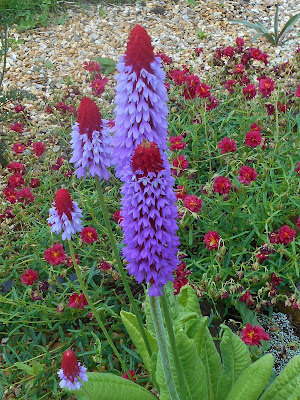In the front the gravel/rock garden is looking very colourful with plants that not only look attractive but are much visited by bees; a win-win situation as far as I am concerned.
Past experience with the lovely Primula vialii has not been very successful and so I put in just one plant with little optimism.
 |
Primula vialii in our front garden at Stefen Hill,
Daventry. 18 June, 2016
|
In fact it has done very well and I am delighted with it. Rather like an elegant Red Hot Poker, it is one of the most distinctive of all primulas and, although it hails from China (N.W.Yunnan and Szechwan), it seems happy with Daventry. Our soil is a sticky clay but when planting anything here I remove this claggy material and replace it with a gritty compost. The strategy seems to be successful.
The Lewisia is doing very well. The label is missing but it is probably Lewisia tweedyi or a hybrid with this as one of the parents. It has been flowering for several weeks and looks like doing so for some time yet. All Lewisias are, as far as I know, natives of North America and more species may yet be found.
 |
This Lewisia, probably L. tweedyi, has flowered for weeks,
Stefen Hill, Daventry. 18 June, 2016
|
South Africa is represented by the succulent Delosperma cooperi.
It is much visited by bees, in this case the Red-tailed Bumble Bee, Bombus lapidarius. The Delosperma genus is in the Aizoaceae family and the genus is apparently confined to Africa south of the equator.
Even more popular with bees are my mounds of thyme. Here, directly to the left of the Delosperma, is a cushion of Thymus praecox 'Coccineus'.
 |
Delosperma cooperi may hail from southern Africa but
British bees are happy with it. Stefen Hill, Daventry 18 June, 2016
|
Even more popular with bees are my mounds of thyme. Here, directly to the left of the Delosperma, is a cushion of Thymus praecox 'Coccineus'.
 |
Delosperma cooperi with, on the left, Thymus praecox 'Coccineus'
Stefen Hill, Daventry. 18 June, 2016
|
In the picture below, a Buff-tailed Bumble Bee, Bombus terrestris, is paying a call, and butterflies are also regular visitors.
 |
Bombus terrestris on thyme. Stefen Hill, Daventry.
18 June, 2016
|
This thyme is an easy-growing plant which I have observed growing in the crevices between paving slabs. It seems able to tolerate a certain amount of wear and so I may try it in a similar position.
My Pasque Flowers, Pulsatilla vulgaris, have now gone to seed and I have gathered and sown a few.
 |
The fluffy seed heads of the Pasque Flower are attractive.
Stefen Hill, Daventry. 18 June, 2016
|
Although the gorgeous purple flowers of this species are incomparable, the feathery seed heads are attractive in their own right. They are not unlike the seed heads of certain Clematis species, such as our native Clematis vitalba, and indeed Clematis and Pulsatilla are both placed in the Buttercup family, the Ranunculaceae.
In creating this gravel garden I find I have unwittingly provided a home for some interesting invertebrates, such as the ant-mimicking spiders, Phrurolithis festivus and Micaria pulicaria. Another bonus.
In creating this gravel garden I find I have unwittingly provided a home for some interesting invertebrates, such as the ant-mimicking spiders, Phrurolithis festivus and Micaria pulicaria. Another bonus.
Still to come are campanulas, saxifrages and dwarf scabious, so there is much to look forward to.
No comments:
Post a Comment